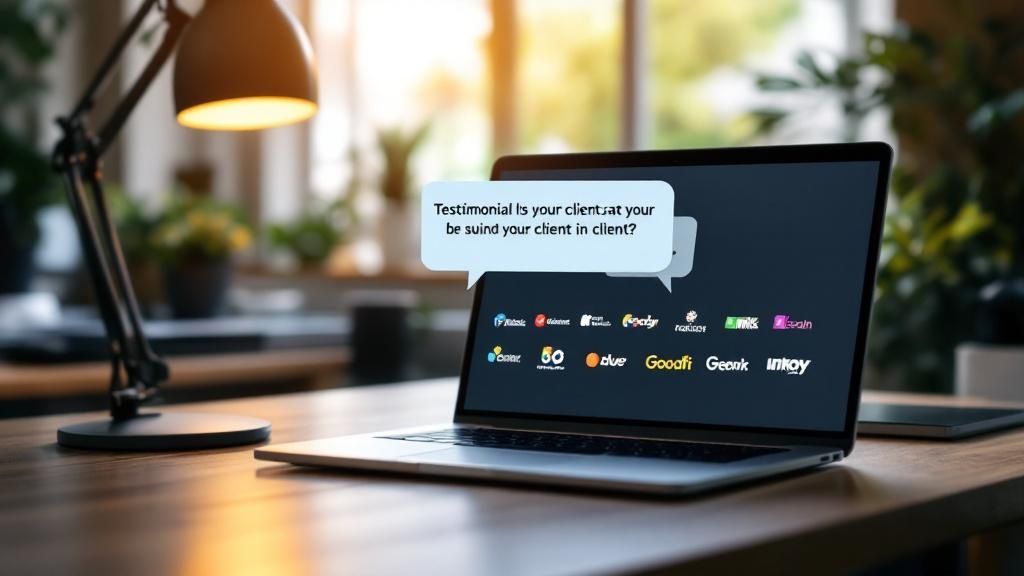You’ve sent the initial pitch, but the reply never came. Now what? The art of the follow-up is where most sales are won or lost, yet many professionals struggle to craft messages that command a response. The silence you’re experiencing isn't always a "no." Often, it’s a sign that your follow-up approach isn't compelling enough to cut through the noise of a busy inbox. Generic, pushy, or uninspired messages get deleted without a second thought, leaving potential revenue on the table.
This guide moves beyond theory to provide actionable, replicable strategies. We will break down six powerful follow up sales email example templates designed to re-engage prospects and drive conversations forward. For each example, you’ll get a detailed analysis of why it works, specific tactical insights, and clear takeaways you can implement immediately.
Before you send another email, ensure it’s even reaching the inbox. A high bounce rate is a silent killer of sales momentum; you can learn how to reduce bounce rates with email validation tools to maximize deliverability. From value-added check-ins to strategic breakup emails, these examples will equip you to turn silence into sales.
1. The Value-Added Follow-Up Email
This follow-up sales email example moves beyond the generic "just checking in" message. Instead of asking for something, you give something. The goal is to provide genuine value to your prospect with helpful resources, industry insights, or relevant tools. This approach builds trust and positions you as a knowledgeable partner, not just a salesperson trying to hit a quota. It's a strategy popularized by thought leaders like HubSpot and Marcus Sheridan, who advocate for educating buyers.

This method works because it respects the prospect's time and intelligence. You demonstrate that you understand their challenges and are invested in their success, regardless of whether they buy from you immediately.
Why This Follow-Up Email Works
The value-added approach is effective because it taps into the principle of reciprocity. When you offer something useful without asking for anything in return, prospects are more likely to feel a sense of obligation to respond or engage. It keeps the conversation alive in a positive and helpful way.
Strategic Insight: This method shines when a prospect has gone cold after an initial positive interaction, like a demo or discovery call. It allows you to re-engage them without seeming pushy or desperate.
How to Implement This Strategy
To execute this effectively, your value-add must be specific and relevant. Generic content won't cut it.
- Research First: Look for recent company news, a LinkedIn post by the prospect, or a new industry challenge. Tailor your resource to this specific context.
- Build a Resource Library: Create and curate a collection of case studies, white papers, blog posts, and webinar recordings. Organize them by industry, role, or common pain points for easy access.
- Use a Soft Call-to-Action (CTA): Instead of "Are you free for a call?", try something less demanding. For example, "Let me know if this resonates with what you're seeing on your end." This invites a conversation without pressure.
- Track Engagement: Use email tracking tools to see which links are clicked. This data provides valuable insight into what your prospect finds most interesting, giving you a perfect topic for your next touchpoint.
2. The Breakup Email
This follow up sales email example is a final, polite attempt to get a response before closing the loop on an unresponsive lead. It's not an aggressive tactic but a professional courtesy. The "breakup email" acknowledges the prospect's silence and clearly states you will no longer be contacting them, which often creates a sense of urgency and prompts a reply. This strategy, championed by sales experts like Josh Braun and the team at Outreach.io, is designed to either re-engage a dormant lead or cleanly close their file.
This method works by leveraging the psychological principle of loss aversion. By suggesting you're "closing their file," you imply they might be missing out on a valuable opportunity. It removes the pressure of a persistent salesperson while simultaneously making them consider what they might lose by not responding.
Why This Follow-Up Email Works
The breakup email is effective because it subverts the typical sales dynamic. Instead of asking for a meeting, you are asking for permission to stop contacting them. This pattern interrupt can be highly effective in a crowded inbox, often generating responses from prospects who have ignored all previous outreach. Outreach.io famously reported that their breakup email sequences generated response rates as high as 33%. For a deeper look into handling no-response situations, you can learn more about crafting the perfect breakup email on salesloop.io.
Strategic Insight: This is a last-resort tool. Use it only after a sequence of 3-4 value-driven follow-ups has gone unanswered. Sending it too early can seem passive-aggressive and may prematurely end a potential relationship.
How to Implement This Strategy
A successful breakup email is concise, respectful, and crystal clear. It's about professional closure, not emotional manipulation.
- Wait for the Right Moment: Only send this after you have made multiple, genuine attempts to connect and provide value. It's the final step in a sequence, not the first.
- Keep it Short and Sweet: The message should be incredibly brief, ideally under 75 words. Get straight to the point without any fluff.
- A/B Test Subject Lines: Your subject line is critical. Test variations like "Permission to close your file?" or "Is it still a priority for [Company Name]?" to see what resonates with your audience.
- Provide a Clear Path Forward: Make it easy for them to re-engage or confirm they're not interested. For example, "If you're still interested, let me know. If not, I'll close your file. Either way, I wish you the best."
- Automate for the Future: Even if they don't respond, don't delete them forever. Use your CRM to set up an automated re-engagement campaign to check in again in 6-12 months. Priorities change, and a "no" today isn't always a "no" forever.
3. The Social Proof Follow-Up Email
This follow-up sales email example leverages one of the most powerful tools in persuasion: social proof. Instead of telling a prospect your solution is great, you show them by highlighting the success of similar customers. This approach uses case studies, testimonials, and notable client wins to build credibility and directly address a prospect's potential skepticism. It shifts the conversation from your claims to proven, real-world results, a tactic championed by marketing experts like Neil Patel and integrated into frameworks like Aaron Ross's Predictable Revenue.

This method works by reducing perceived risk. When a prospect sees that a company just like theirs has already solved a similar problem using your product, it makes the decision to engage feel much safer and more logical. It’s the B2B equivalent of reading a positive review before buying a product online.
Why This Follow-Up Email Works
The Social Proof Follow-Up is effective because it taps into the psychological principle of conformity. People are more likely to take a certain action if they see others doing it. By showcasing success stories, you help the prospect envision their own success and feel more confident in moving forward. This is a perfect example of a follow up sales email that builds trust through validation.
Strategic Insight: Use this follow-up when a prospect has expressed interest but is hesitant about the investment or potential ROI. A powerful case study can directly counter their concerns by providing concrete evidence of value from a trusted, third-party source.
How to Implement This Strategy
The key to a successful social proof email is relevance. The more the customer story mirrors the prospect's situation, the more impactful it will be.
- Match the Profile: Select a case study or testimonial from a company in the same industry, of a similar size, or with a similar role to your contact. For example, if you're emailing a VP of Sales at a mid-sized tech company, send them a story about another VP of Sales at a mid-sized tech company.
- Highlight Specific Metrics: Don't just say a client was "successful." Quantify it. Use hard numbers like "They reduced operational costs by 22% in six months" or "They increased lead conversion rates by 40%."
- Use a Compelling CTA: Your call-to-action should connect the case study to the prospect's potential outcome. Try something like, "I'm confident we could achieve similar results for [Prospect's Company]. Are you open to a brief call next week to discuss how?"
- Get Permission First: Always secure explicit, written permission from your clients before featuring their name, logo, or results in your sales materials. This protects your relationships and ensures you're operating ethically.
4. The Question-Based Follow-Up Email
This follow-up sales email example shifts the dynamic from telling to asking. Instead of presenting information or making a pitch, you use strategic, open-ended questions to re-engage a prospect. The goal is to stimulate thought, uncover new information, and restart a stalled conversation by making the prospect the focus. This method, influenced by frameworks like SPIN Selling and advocated by sales trainers like Jeb Blount, turns a monologue into a dialogue.
This approach is powerful because it encourages the prospect to reflect on their own situation, challenges, and goals. A well-crafted question can reveal critical details about their decision-making process, timeline, or unseen obstacles, providing you with the exact information you need to move the deal forward.
Why This Follow-Up Email Works
The question-based approach is effective because it's rooted in curiosity and problem-solving. It demonstrates that you are genuinely interested in the prospect's world and are trying to understand before you try to sell. This builds rapport and positions you as a consultant rather than just another vendor. It naturally invites a response because people are often inclined to answer a direct, thoughtful question.
Strategic Insight: Use this method when you suspect the prospect's priorities have shifted or when you need to uncover the root cause of their silence. It's a diagnostic tool that helps you understand their current reality without making assumptions. For instance, asking about their lead qualification process (like Drift) or data visualization workflows (like ChartIO) can reveal immediate needs.
How to Implement This Strategy
The success of this strategy hinges on the quality and relevance of your questions. Generic inquiries will be ignored, but insightful ones will get replies.
- Do Your Homework: Research the prospect's company or industry to ask a highly specific question. For example, "I saw your company just launched Project X; how are you planning to measure its impact on lead generation this quarter?"
- Focus on Goals, Not Just Problems: Frame questions around future objectives. Instead of "What problems are you having?", try "As you plan for Q4, what's the biggest hurdle you see in achieving your team's goal of [specific goal]?"
- Keep It Singular and Focused: Don't overwhelm them. Stick to one or two well-chosen questions in a single email. Too many questions can feel like an interrogation and will reduce your chances of getting a response.
- Use Questions to Qualify: A question can gently probe for buying authority. For example, "Who else on the team is typically involved when evaluating new analytics tools?" This is a classic follow up sales email example of gathering intel gracefully. If you're looking for more ways to tailor your outreach, you can learn more about how to personalize your sales outreach at scale.
5. The Trigger Event Follow-Up Email
This follow-up sales email example capitalizes on a specific, timely event related to the prospect or their company. A "trigger event" can be anything from a new funding round, an executive hire, a company expansion, or a major industry award. Reaching out with this context makes your message hyper-relevant and demonstrates that you are actively paying attention to their journey. This approach is a core tenet of modern account-based marketing and is heavily advocated by platforms like LinkedIn Sales Solutions.
This method cuts through the noise because it's not based on your sales cadence; it's based on their business reality. It shows you’ve done your homework and are contacting them with a clear, purpose-driven reason that aligns with their current situation.
Why This Follow-Up Email Works
The trigger event email is powerful because it creates an immediate and undeniable context for your outreach. It answers the prospect's silent question, "Why are you contacting me now?" By referencing a recent development, you position your solution not as a generic product, but as a specific tool to help them navigate their current change or opportunity.
Strategic Insight: Timing is everything. The value of a trigger event diminishes quickly. Reaching out within a few days of the news breaking is crucial to making an impact and showing you are on the ball.
How to Implement This Strategy
A successful trigger event strategy relies on proactive monitoring and quick, decisive action.
- Set Up Alerts: Use tools like Google Alerts or Mention to monitor news for your target companies. Set alerts for keywords like "funding," "expansion," "hires," or "acquisition."
- Leverage Social Media: Actively follow your top prospects and their companies on LinkedIn. The platform's newsfeed is often the first place where leadership changes or company milestones are announced.
- Connect the Dots Clearly: Don't just mention the event; directly connect it to a potential challenge or opportunity they now face. For example, if they just got Series B funding, mention how your service helps companies scale efficiently post-investment.
- Keep Your Message Concise: Acknowledge the event, make your connection, and propose a next step. The trigger is the hook; you don't need to write a novel. A short, impactful message is more likely to be read and receive a reply.
6. The Multi-Channel Follow-Up Email
This follow up sales email example acknowledges that a single channel is often not enough to capture a busy prospect's attention. Instead of sending isolated emails, this strategy integrates outreach across multiple platforms like email, LinkedIn, and phone calls. It demonstrates respectful persistence and transparency by consolidating the outreach into a cohesive sequence, which often boosts credibility and reply rates. This approach is a core methodology for modern sales development teams and is championed by sales engagement platforms like Outreach.io.
This method works because it meets prospects where they are. Someone who ignores emails might be active on LinkedIn, while another may prefer a quick phone call. By varying the touchpoints, you increase the probability of connection. This coordinated outreach shows you are organized, professional, and serious about connecting, which can differentiate you from competitors sending generic, one-off emails.
Why This Follow-Up Email Works
The multi-channel approach is effective because it combats digital noise. A prospect's inbox is crowded, but their LinkedIn messages or voicemail might be less saturated. By referencing previous touchpoints (e.g., "I sent an email last week regarding…"), you create a continuous thread that builds familiarity and context. This makes your final follow-up email feel less like a cold outreach and more like a final, helpful nudge in an ongoing conversation.
Strategic Insight: This strategy is ideal for high-value prospects or accounts where a deeper level of persistence is justified. It ensures all avenues have been explored before marking a lead as unresponsive, maximizing the potential of every lead in your pipeline. Learn more about developing a comprehensive multichannel sales strategy on salesloop.io.
How to Implement This Strategy
A successful multi-channel sequence requires careful planning and tracking to avoid overwhelming the prospect.
- Space Out Touchpoints: Plan your sequence over several days or even weeks. A common approach is an email on Day 1, a LinkedIn connection request on Day 3, and a phone call on Day 7. This prevents you from seeming desperate.
- Vary the Message: Don't just copy and paste the same message across channels. Tailor the content to the platform. Use a formal email, a more conversational tone on LinkedIn, and a concise script for voicemails.
- Reference Previous Attempts: When you finally send the consolidating email, mention your other attempts professionally. For example: "I left a voicemail and sent a LinkedIn message last week to connect about [Topic]."
- Use a CRM to Track Everything: Accurately log every email, call, and social media interaction in your CRM. This prevents embarrassing mistakes like contacting a prospect after they've already replied on a different channel.
Follow-Up Sales Email Types Comparison
| Follow-Up Email Type | Implementation Complexity 🔄 | Resource Requirements 💡 | Expected Outcomes 📊 | Ideal Use Cases 💡 | Key Advantages ⭐ |
|---|---|---|---|---|---|
| The Value-Added Follow-Up Email | Moderate – requires research and content curation | High – creating and maintaining quality resources | Builds trust and credibility; moderate immediate sales | Nurturing prospects and building expert positioning | Positions sender as trusted expert; high engagement due to valuable content |
| The Breakup Email | Low – simple, concise & final message | Low – minimal content needed | Often increases responses; cleans database | Re-engaging dormant leads or closing unresponsive contacts | Creates urgency without pressure; provides closure and frees resources |
| The Social Proof Follow-Up Email | Moderate – needs fresh permissioned content | Medium – collecting testimonials and case studies | Reduces buyer skepticism; increases conversion rates | Overcoming objections and validating product/service | Demonstrates proven results; appeals to herd mentality |
| The Question-Based Follow-Up Email | Moderate – requires thoughtful, industry-specific questions | Medium – needs industry knowledge and research | Encourages dialogue; gathers prospect intelligence | Engaging prospects for consultative selling | Positions sender as consultant; uncovers hidden pain points |
| The Trigger Event Follow-Up Email | High – requires constant monitoring and timely relevance | High – time-intensive research on recent events | Highly relevant; higher open and response rates | Capitalizing on company news or changes for timely outreach | Shows genuine interest; demonstrates market awareness |
| The Multi-Channel Follow-Up Email | High – complex coordination across channels | High – managing multiple platforms and messages | Increased brand recall and response rates | Persistent outreach over multiple platforms | Organized, professional approach; breaks through busy schedules |
Automate Your Follow-Up and Start Winning More Deals
We've explored a powerful arsenal of follow-up sales email examples, moving far beyond generic templates to dissect the underlying strategy that makes them effective. From the gentle nudge of a value-added resource to the decisive finality of a breakup email, each approach serves a distinct purpose in your sales cadence. The key isn't just to copy and paste; it's to understand the why behind each word.
The most successful sales professionals recognize that a follow-up is not a nuisance but an opportunity. It's a chance to demonstrate persistence, add genuine value, and stay top-of-mind in a crowded market. Whether you're referencing a recent trigger event or leveraging powerful social proof, your goal is to re-engage your prospect with relevance and respect for their time.
Your Path to Follow-Up Mastery
Mastering the art of the follow-up hinges on a few core principles we've discussed. Let's recap the most critical takeaways:
- Personalization is Paramount: Generic emails get deleted. Your follow-up must reflect your knowledge of the prospect's role, company, or recent activities. This is what separates a thoughtful message from spam.
- Always Add Value: Never send an email just to "check in." Each communication should offer something new: a helpful article, a relevant case study, a solution to a potential problem, or an insightful question.
- Timing and Cadence Matter: The "when" is just as important as the "what." A well-timed email after a trigger event or a strategic pause before a breakup email can dramatically increase your chances of getting a reply.
- Clarity is King: Your call to action must be simple and direct. Don't make the prospect guess what you want them to do next. A clear question or a specific suggested time for a meeting removes friction.
Implementing Your Strategy at Scale
Applying these principles consistently across dozens or hundreds of leads can seem daunting. This is where strategic automation becomes a game-changer. By building these proven templates into your sales outreach platform, you can ensure every prospect receives a thoughtful, well-timed sequence of communications without overwhelming your team.
For teams looking to enhance their efficiency even further, consider leveraging an AI-powered tool to streamline communication within your existing CRM. An AI Co-Pilot for Salesforce and Slack can help draft responses, summarize conversations, and ensure your messaging stays on point, allowing your sales reps to focus on building relationships rather than administrative tasks.
Ultimately, a strong follow-up strategy is the engine of a successful sales pipeline. By adopting these examples and integrating them into a systemized process, you transform silence into conversation, objections into opportunities, and prospects into loyal customers. The perfect follow up sales email example isn't just one template; it's a versatile toolkit you can deploy to win more deals.
Ready to put these strategies into action with powerful automation? Salesloop.io helps you build, personalize, and launch effective email outreach campaigns in minutes. Stop manually tracking follow-ups and start closing more deals by visiting Salesloop.io to see how our platform can transform your sales process.





